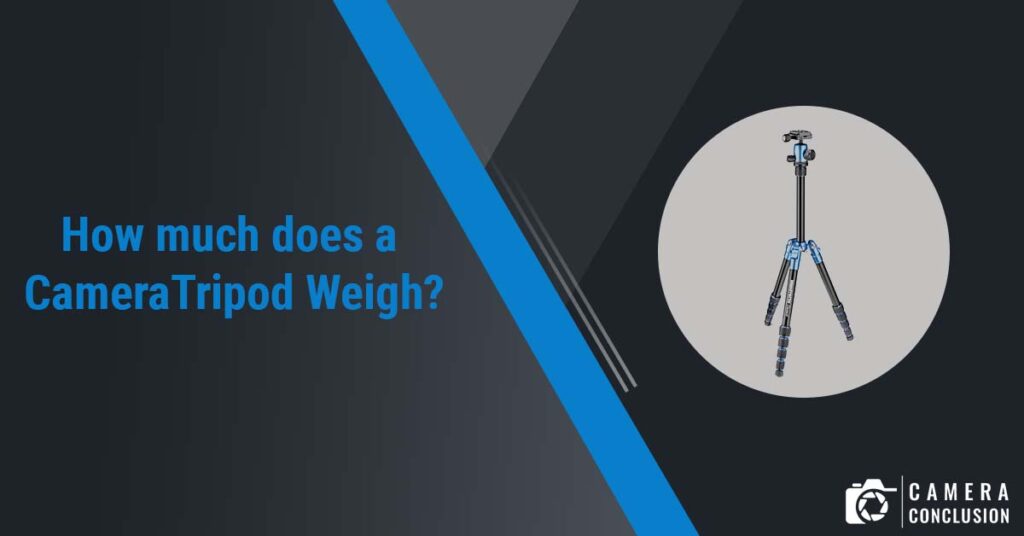Index
Camera tripods are essential tools for photographers and videographers to capture stable and clear images and videos. However, their weight can play a significant role in determining their usability and portability. A tripod that is too heavy can be challenging to carry around, especially during outdoor shoots, while a tripod that is too light might not provide enough stability for your camera. So, it’s essential to know the weight of a tripod to determine its suitability for your needs. In this article, we will explore the weight of camera tripods, factors that can affect their weight, and how to choose the right tripod weight for your photography and videography needs.
Factors Affecting the Weight of a Tripod
Material
- Material: The type of material used to make the tripod will greatly impact its weight. Tripods can be made from a variety of materials, including aluminum, carbon fiber, and steel, among others. Generally, aluminum tripods are heavier than carbon fiber ones, but they are also more affordable.
- Leg Diameter: The diameter of the legs will affect the weight of the tripod. Generally, tripods with thicker legs are heavier than those with thinner legs, but they are also more stable.
- Leg Sections: The number of leg sections can also affect the weight of the tripod. Tripods with more leg sections are more compact and easier to transport, but they can also be heavier.
- Maximum Load Capacity: The maximum load capacity of the tripod will also affect its weight. Tripods with a higher load capacity are generally heavier because they need to be more sturdy and able to support heavier equipment.
- Center Column: The weight of the center column will also affect the overall weight of the tripod. Tripods with a removable center column can be lighter because you can choose not to use it, while those with a fixed center column will be heavier.
- Head: The type of head you use on your tripod will also affect its weight. Ball heads are generally lighter than three-way pan-tilt heads, but they may not offer as much precision.
Size and Height
- Size: The overall size of the tripod will impact its weight. A larger tripod will typically be heavier than a smaller one due to the additional materials required to make it. However, a larger tripod can also provide greater stability and support heavier equipment.
- Height: The maximum height of the tripod will also affect its weight. A taller tripod will typically be heavier than a shorter one because it requires longer legs and additional materials to maintain stability at higher heights. However, a taller tripod can be more versatile and provide better shooting angles.
- Minimum Height: The minimum height of the tripod can also impact its weight. Tripods that can be collapsed to a smaller size are generally more portable and easier to carry, but they may not provide the stability of larger, heavier tripods.
- Leg Locks: The type of leg locks on the tripod can also impact its weight. Tripods with twist locks are generally lighter than those with flip locks, but they may take longer to set up and adjust.
- Feet: The type of feet on the tripod can also impact its weight. Rubber feet are typically lighter than spiked feet, but they may not provide as much grip on slippery surfaces.

Load Capacity
The load capacity of a tripod, which is the maximum weight it can support, can also affect its overall weight. Here are some factors related to load capacity that can impact the weight of a tripod:
- Materials: Tripods made of materials that can support higher weight loads, such as steel or heavy-duty aluminum alloys, will generally be heavier than those made of lighter materials.
- Leg Diameter and Wall Thickness: Larger leg diameters and thicker leg walls can help support heavier loads, but they also add to the overall weight of the tripod.
- Number of Leg Sections: Tripods with more leg sections may be more versatile and easier to pack, but they may not be able to support as much weight as tripods with fewer leg sections, all else being equal.
- Center Column: Tripods with a center column may have a higher load capacity, but the center column itself can add weight to the tripod.
- Head: The type of tripod head used can also impact the overall weight of the setup. A heavier duty head capable of supporting larger loads will add weight to the tripod.
Number of Leg Sections
- Materials: The materials used in the construction of the tripod’s legs can impact the weight of the tripod. A tripod with more leg sections will generally require more materials, which can make it heavier.
- Sturdiness: A tripod with more leg sections can provide greater stability and sturdiness, which can be particularly important for heavier cameras and equipment. However, this added sturdiness may come at the cost of increased weight.
- Compactness: Tripods with more leg sections can typically be collapsed to a smaller size, making them easier to transport. However, this increased portability may come at the cost of increased weight due to the additional leg sections.
- Set up time: Tripods with more leg sections may take longer to set up and adjust than those with fewer leg sections, which can be a consideration for photographers who need to work quickly.
Additional Features
- Built-in level: Some tripods have a built-in level to help ensure that the camera is level. This feature can add a small amount of weight to the tripod.
- Center column: Some tripods have a center column that can be extended to raise the camera higher. While this can be a useful feature, the center column can add weight to the tripod.
- Monopod conversion: Some tripods can be converted into a monopod, which can be useful for certain types of photography. However, the mechanism used to convert the tripod can add weight.
- Hooks: Some tripods have hooks on the center column or legs that can be used to hang a weight for added stability. These hooks can add a small amount of weight to the tripod.
- Multiple leg angle settings: Tripods with multiple leg angle settings can provide greater versatility, but the added mechanism to enable this feature can add weight.
Types of Tripods and their Weight
Tabletop Tripods
Tabletop tripods are small, compact tripods that are designed to sit on a table or other flat surface. They are often used for close-up photography or video work and are typically designed to support lightweight cameras or mobile devices. The weight of tabletop tripods can vary depending on their size, materials, and other features, but they generally weigh less than larger tripods.
Here are some examples of the weights of popular tabletop tripods from different manufacturers:
- Manfrotto PIXI Mini Tripod – 0.51 lbs (0.23 kg)
- Joby GorillaPod 1K – 0.44 lbs (0.2 kg)
- MeFOTO SideKick360 – 0.56 lbs (0.25 kg)
- Benro PocketPod – 0.32 lbs (0.14 kg)
- Pedco UltraPod II – 0.12 lbs (0.05 kg)
It’s important to note that the weight of a tabletop tripod can impact its stability. Heavier tripods may provide more stability for your camera, while lighter tripods may be more prone to tipping or wobbling. When choosing a tabletop tripod, consider the weight of your camera or device and how much stability you need for your specific photography or video needs.

Compact Tripods
Compact tripods are designed to be lightweight and portable, making them a popular choice for travel or outdoor photography. They are typically smaller and more lightweight than full-size tripods, but can still provide a stable base for your camera or other equipment. The weight of compact tripods can vary depending on their size, materials, and other features.
Here are some examples of the weights of popular compact tripods from different manufacturers:
- Manfrotto Element Traveler Small – 2.53 lbs (1.15 kg)
- Joby GorillaPod 3K Kit – 2.6 lbs (1.18 kg)
- MeFOTO BackPacker Air – 1.98 lbs (0.9 kg)
- Benro Aero 2 Travel Tripod – 2.9 lbs (1.32 kg)
- Induro Alloy 8M AT214 Tripod – 3.1 lbs (1.4 kg)
When choosing a compact tripod, it’s important to consider both weight and stability. A tripod that is too lightweight may not provide enough stability for your camera or other equipment, while a heavier tripod may be more difficult to carry and transport. Additionally, consider the maximum load capacity of the tripod, as it will need to support the weight of your camera and any other equipment you plan to use.
Standard Tripods
Standard tripods are the most common type of tripod and are typically used for general photography and videography. They provide a stable base for your camera or other equipment, and are often adjustable to allow for different angles and heights. Standard tripods can vary in weight depending on their size, materials, and load capacity.
Here are some examples of the weights of popular standard tripods from different manufacturers:
- Manfrotto 190XPROB – 4.41 lbs (2 kg)
- Gitzo GT1545T Series 1 Traveler – 2.2 lbs (1 kg)
- Benro Adventure MAD49A Aluminum Tripod – 4.08 lbs (1.85 kg)
- Induro Alloy 8M AT214 Tripod – 3.1 lbs (1.4 kg)
- MeFOTO GlobeTrotter Air – 2.5 lbs (1.13 kg)
When choosing a standard tripod, it’s important to consider the weight of your camera and other equipment, as well as the tripod’s load capacity. A tripod that is too lightweight may not provide enough stability for heavier equipment, while a heavier tripod may be more difficult to transport. Additionally, consider the maximum and minimum height of the tripod, as well as any additional features that may impact its weight.
Heavy-duty Tripods
Heavy-duty tripods are designed for professional photographers and videographers who require maximum stability and support for heavy camera equipment, lenses, and other accessories. They are typically made from more robust materials and are built to withstand harsh conditions and frequent use. As a result, they are generally heavier than other types of tripods.
Here are some examples of the weights of popular heavy-duty tripods from different manufacturers:
- Gitzo GT5543LS Systematic Series 5 – 7.72 lbs (3.5 kg)
- Manfrotto MT055CXPRO4 – 5.51 lbs (2.5 kg)
- Induro Alloy 8M AT214 Tripod – 3.1 lbs (1.4 kg)
- Sachtler 1001 ACE XL Fluid Head Tripod System – 8.82 lbs (4 kg)
- Benro C674T Carbon Fiber Tripod – 7.3 lbs (3.3 kg)
When choosing a heavy-duty tripod, it’s important to consider both weight and load capacity. A tripod that is too heavy may be difficult to transport, especially when hiking or traveling to different locations. However, a tripod that is not sturdy enough to support your equipment can lead to camera shake and blurry images. Additionally, consider the materials used in the tripod’s construction, as well as any additional features that may impact its weight or stability.
Average Weight of Tripods
The average weight of camera tripods can vary depending on the type of tripod and its intended use. Tabletop and compact tripods are generally lighter and more portable, while heavy-duty and studio tripods are typically heavier and more stable. On average, a standard tripod for general photography and videography can weigh between 3 to 5 pounds (1.4 to 2.3 kg).
However, it’s important to note that the weight of a tripod is just one of many factors to consider when choosing the right tripod for your camera and shooting style. Other factors, such as load capacity, height, leg sections, and additional features, should also be taken into account.
It’s also worth noting that some manufacturers are creating more lightweight tripods to meet the needs of photographers and videographers who are constantly on the move. For example, carbon fiber tripods are generally lighter than those made from aluminum, although they can be more expensive. Additionally, some tripods are designed to be collapsible, which can make them easier to transport.
Ultimately, the weight of a tripod should be balanced against its stability and load capacity. A tripod that is too light may not provide enough stability for your camera and other equipment, while a tripod that is too heavy may be difficult to carry and transport. By taking into account your specific needs and shooting style, you can choose a tripod that strikes the right balance between weight and stability.
Considerations When Choosing a Tripod Based on Weight
When choosing a camera tripod, weight is an important factor to consider, as it can impact the stability and portability of the tripod. Here are some considerations to keep in mind when choosing a camera tripod based on its weight:
- Camera and equipment weight: The weight of your camera and other equipment should be taken into account when choosing a tripod. A tripod that is too lightweight may not provide enough stability for heavier equipment, while a heavier tripod may be necessary to support heavier gear.
- Load capacity: The load capacity of the tripod should also be considered in relation to the weight of your camera and other equipment. The load capacity indicates how much weight the tripod can support, so it’s important to choose a tripod that can safely hold your gear.
- Intended use: The intended use of the tripod can also impact the weight. For example, if you plan to use the tripod for hiking or traveling, you may want to choose a lighter tripod that is easier to carry. On the other hand, if you will be using the tripod in a studio setting, you may prioritize stability over weight.
- Height and adjustability: The height and adjustability of the tripod can also impact its weight. A taller tripod may be heavier due to the additional leg sections and materials needed to provide stability at a greater height. Additionally, a tripod with more adjustable features, such as a center column or ball head, may also be heavier.
- Materials: The materials used in the construction of the tripod can also impact its weight. Aluminum tripods are generally heavier than carbon fiber tripods, but they may also be more affordable. Some manufacturers are also using innovative materials, such as magnesium, to create lightweight yet sturdy tripods.
FAQs
Conclusion
In conclusion, the weight of a camera tripod can vary depending on its size, material, and construction. The weight of a tripod is an important consideration for photographers and videographers who need to transport their equipment to different locations. While a heavier tripod can provide more stability and support for larger cameras and lenses, a lighter tripod can be more convenient for travel and outdoor shoots. Ultimately, the choice of tripod weight will depend on the specific needs and preferences of the individual user. It is important to consider the weight of the tripod along with other factors such as durability, versatility, and cost when choosing the best option for your photography or videography needs.
